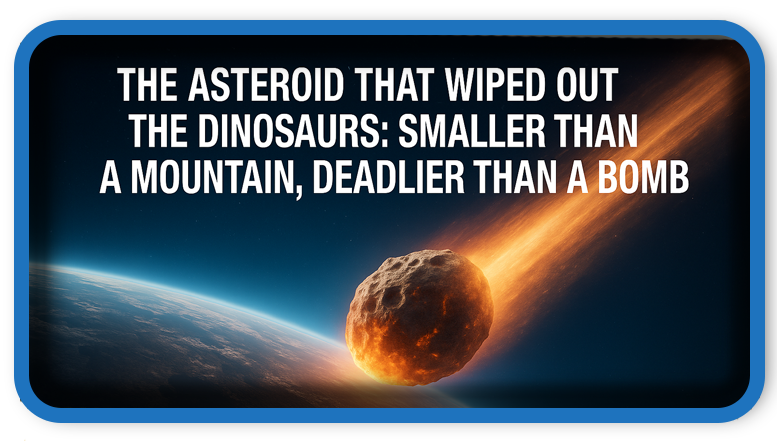⏲️ Estimated reading time: 4 min
The Asteroid That Wiped Out the Dinosaurs: Smaller Than a Mountain, Deadlier Than a Bomb. Around 66 million years ago, an asteroid no larger than 12 kilometers in diameter changed Earth forever. Its tremendous speed not size unleashed global devastation that caused mass extinction and reshaped the planet’s future.
The Asteroid That Wiped Out the Dinosaurs: Smaller Than a Mountain, Deadlier Than a Bomb
A Mountain-Sized Misunderstanding
When we imagine the asteroid that led to the extinction of the dinosaurs, we often picture a colossal space rock as massive as a continent. But in truth, it measured just 10 to 12 kilometers in diameter a size that pales in comparison to Mount Everest, which towers at nearly 9,000 meters with a base stretching over 20 kilometers.
Despite being physically smaller than a mountain, this asteroid now known as the Chicxulub impactor carried far more destructive power than anything Earth has ever experienced before.
It Wasn’t the Size It Was the Speed
What made the Chicxulub asteroid apocalyptic wasn’t its mass, but its incredible velocity. Traveling at over 20,000 kilometers per hour when it struck Earth, it released energy equivalent to more than 100 million megatons of TNT. That’s billions of times more powerful than the atomic bomb dropped on Hiroshima.
This explosion was beyond anything humanity can currently comprehend or reproduce. In just a fraction of a second, the planet’s fate shifted dramatically.
A Chain Reaction of Catastrophes
The impact site now buried beneath the Yucatán Peninsula in Mexico formed a crater more than 180 kilometers wide. But the destruction did not stop there. The energy unleashed created a mega-tsunami over 1,000 meters high, massive earthquakes, and global wildfires that incinerated forests and animal life across continents.
Worse still, the atmosphere became choked with dust, ash, and sulfur, forming a dense shield that blocked sunlight for years. Photosynthesis the foundation of nearly all life on Earth ceased. With plants dying, herbivores followed, and then carnivores soon after.
This sudden darkness led to what scientists call a “planetary winter” a global cooling event that devastated ecosystems on a mass scale.
When Did It Happen?
These catastrophic events unfolded approximately 66 million years ago, marking the boundary between the Cretaceous and Paleogene periods (often abbreviated as the K–Pg extinction event).
The consequences were profound: roughly 75% of all species on Earth went extinct, including the non-avian dinosaurs. Coral reefs collapsed, entire food chains disintegrated, and the Earth entered one of its darkest evolutionary chapters.
A Devastating End And a New Beginning
Ironically, the same disaster that ended the age of dinosaurs also cleared the way for mammals to rise and eventually for humans to evolve. The Chicxulub impact served as a kind of planetary reset button.
Without that asteroid, dinosaurs might still dominate Earth today. Life, as we know it, simply wouldn’t exist.
So, while Chicxulub was smaller than Everest, it was large enough, fast enough, and destructive enough to rewrite the history of our planet forever.

Final Thoughts on the Chicxulub Cataclysm
Events like the Chicxulub impact remind us of the fragility of life on Earth. It doesn’t take a planet-sized object to cause global extinction just the right object, moving fast enough, hitting in just the wrong place.
Even today, scientists closely monitor near-Earth objects, understanding that while rare, these cosmic threats are very real.
🔔 For more tutorials like this, consider subscribing to our blog.
📩 Do you have questions or suggestions? Leave a comment or contact us!
🏷️ Tags: Chicxulub impact, dinosaur extinction, mass extinction, asteroid impact, Earth history, Cretaceous period, global catastrophe, prehistoric events, K-Pg extinction, science facts
📢 Hashtags: #Chicxulub, #Dinosaurs, #AsteroidImpact, #MassExtinction, #ScienceFacts, #EarthHistory, #Cretaceous, #Geology, #SpaceThreats, #ExtinctionEvent
What This Meant for Earth’s Story
The Chicxulub asteroid may have been modest in size, but its effect was titanic. It didn’t just end an era it made room for a new one. It ended the reign of the dinosaurs, but ultimately made our own story possible.
Only logged-in users can submit reports.
Discover more from HelpZone
Subscribe to get the latest posts sent to your email.

